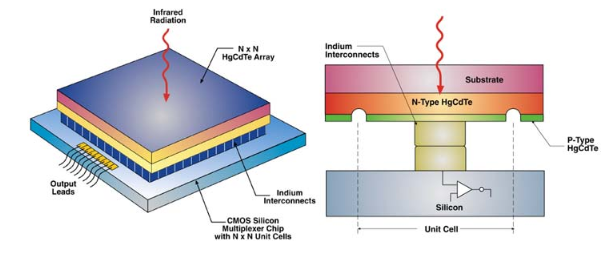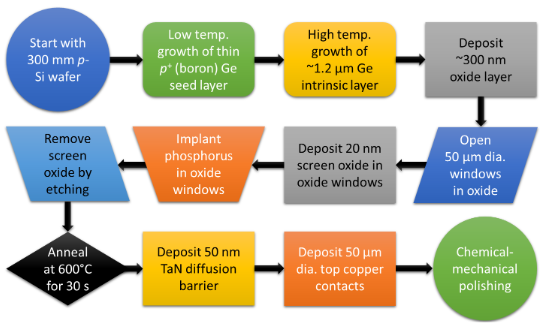

Recent advances in HgCdTe, micro-bolometers and SiGe technology have enabled a new generation of infrared technology including multi-spectral instruments for various military, space and medical applications. These technologies have led to the development of single and dual-band IR focal plane arrays. Our detector and focal plane array efforts offer advantages at the system level for weight reduction, lower cost and higher sensitivity in spectral bands of interest. Our strategy includes accurate modeling and simulation to reduce initial materials and system development costs. For the past few years our focus has been on HgCdTe materials for thermal (LWIR) applications that stem from the market growth in the medical and military sectors. We have also focused on SiGe as an alternative technology to InGaAs for short wave infrared applications. The short wave technology is also needed to address the growing market in industrial, agricultural and military sectors.
Our typical approach to HgCdTe FPAs is a hybrid design. By far the most important application of HgCdTe arrays is in large two-dimensional hybrid FPAs. A hybrid HgCdTe FPA consists of a two-dimensional HgCdTe photovoltaic detector array that is interfaced electrically, thermally and mechanically with a matching two-dimensional array of input circuits in a Readout Integrated Circuit chip. Each HgCdTe detector element in the array has one electrical connection to its matching input circuit node in the silicon ROIC. For simultaneous multi-color detection, there are two interconnect per unit cell for input signal for each color in to the silicon ROIC. The advantages of the back-illuminated configuration are several. The detector processing is done prior to integration with the silicon ROIC, allowing use of pre-tested ROIC chips. The entire area of each detector in the array is optically active; there are no losses due to contact holes or contact grid metallization layers. Each HgCdTe detector element in the array has one electrical connection to its matching input circuit node in the silicon ROIC.

Reference
"M. B. Reine, "Photovoltaic Detectors in HgCdTe," Chapter 12 in Infrared Detectors and Emitters: Materials and Devices, ed. by P. Capper and C. T. Elliott (Kluwer Academic Publishers, Boston, 2000)."
We are also developing SiGe based short wave FPA technology. Our process is on 12-inch substrates to reduce cost per die. Ou SiGe process allows for low dark currents and high signal to noise ratio. The SiGe process is being developed at the CNSE foundry.

Overall, we are focused on short wave and long wave applications to address the relevant market sectors that require these types of imaging systems. Further, our offerings also includes UV detectors and FPAs for various NASA, commercial and military applications.